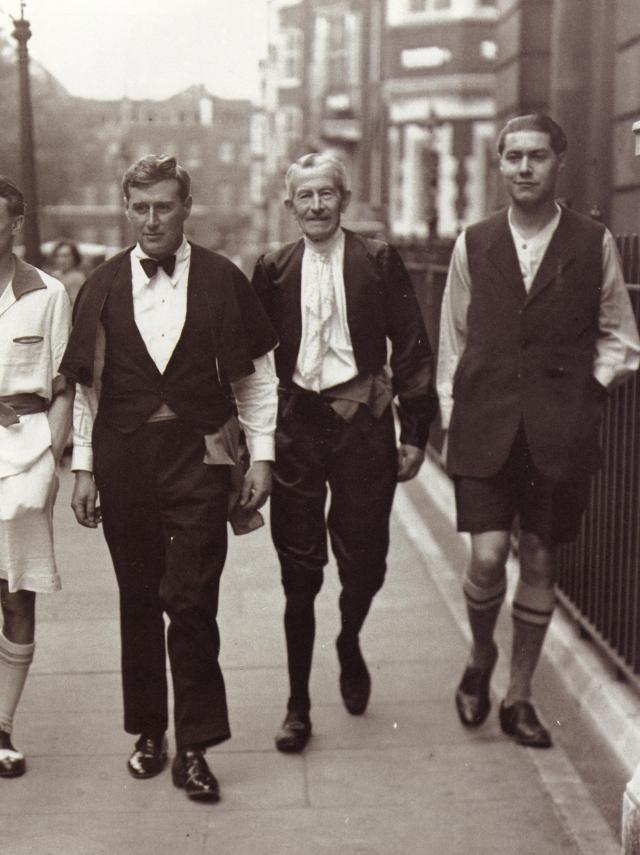THE FOURTH ISSUE OF Vestoj, On Fashion and Power. features an essay by the esteemed fashion academic Shaun Cole on Eldridge Cleaver; the Black Panther cum fashion designer of the eccentric, and ambitious piece of menswear, the ‘Penis Pants’. Historically, Cleaver was not the first to take on the perceived physical and social constraints of men’s clothing. The little-known Men’s Dress Reform Group (MDRG) of the early twentieth-century was instigated as an offshoot of the New Health Society in central London, and is another example of such a movement. Founded in 1929 (and disbanding in 1940) by renowned radiologist Alfred Jordan, along with a collection of eugenicists, the party was formed with the intention of furthering the human race through men’s dress and correcting its various physical and social constraints by addressing the health concerns of highly tailored and un-washable men’s dress of the time, as well as outlining aesthetic reform, that attempted to further the beauty of men.

The proposed silhouette of the MDRP was not only outlined to be looser, more comfortable; but also encouraged garments in brighter colours and a more personally expressive approach to dressing that would supposedly make men more aesthetically pleasing, and therefore more attractive to their female counterparts. For instance, trousers were condemned by the party to be ‘horrible contraptions-tho stupidest, dirtiest garments yet devised, unaesthetic in their gaunt tubularity, and having the serious disadvantages of being damp and dust collectors, especially when the ends are permanently turned up.’ Historian Joanna Burke explains in an article on the MDRP that the party believed ‘middle-class men were oppressed by the disciplines imposed by capitalist labour. […] The tailoring profession, in particular, was responsible for men’s chronic unhappiness which resulted from being forbidden any creative role in fashioning their own bodies through the use of clothing.’1 Furthermore, in the context of the emerging technologies of the time, at the cusp of mass-production; lightweight, easy-care and breathable garments, particularly those associated with sportswear, were becoming more readily available, and at a cheaper price. Despite this, the designs created by the party were original, and customised to suit the political views and policies laid out by them, reflecting a sort of politically-driven design approach.
The MDRP also had deeper significance in addressing how we define fashion, and its role in our lives as individuals and social collectives: party member John Carl Flügel went on to publish The Psychology of Clothes in 1930, largely regarded as the first psychoanalysis of clothes. The work investigates more deeply what role dress has in our perception of ourselves; Flügel contends that, ‘The exhibitionistic instinct originally relates to the naked body, but in the course of individual development it inevitably (in civilised races) becomes displaced, to a greater or lesser extent onto clothes. Clothes are, however, exquisitely ambivalent, in as much as they both cover the body and thus subserve the inhibiting tendencies that we call ‘modesty’, and at the same time afford a new and highly efficient means of gratifying exhibitionism on a new level.’2 Although Flügel is today regarded as a substantial figure in the landscape of fashion academia, needless to say, the party itself was not so successful in this grander scheme and remains a sort of novelty in the history of politics and dress, much like the Futurists before them.
Contemporary efforts towards men’s grooming, involving increased attention to almost every aspect of the presentation of a man, from beauty, suiting to undergarments are a product of an increased interest in men’s fashion which, for some time, was deemed to be a domain left to itself. Although more recent trends for change or liberation of dressing (sneakers, for example) for both men and women drift in and out of fashion, reflective of consumer behaviour and desires, rather than political policy, the Men’s Dress Reform Party echoes an era where dress was a serious political and social matter. The MDRP, like Cleaver, was concerned with the empowerment of men for a better social outcome, however both cases proved to be largely unsuccessful as a viable solution in the context of the industry.